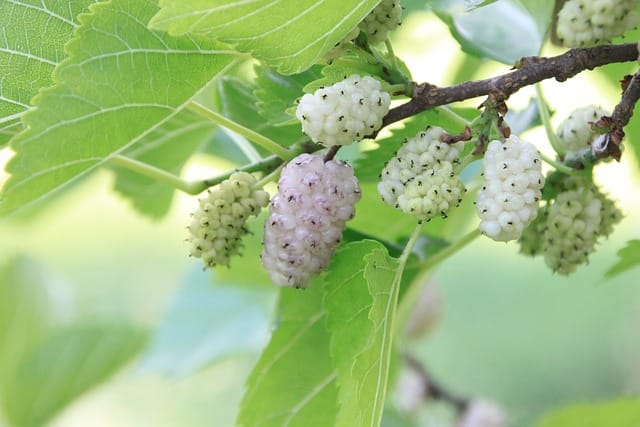How to grow Mulberries
Mulberries are a delicious and nutritious fruit that can be grown in your own backyard

In this article:
- Introduction to Mulberries
- Choosing the Right Variety
- Climate and Soil Requirements
- Planting Mulberry Trees
- Mulberry Tree Care and Maintenance
- Watering and Fertilizing Mulberry Trees
- Pruning and Training Mulberry Trees
- Dealing with Pests and Diseases
- Harvesting Mulberries
- Storing and Using Mulberries
- Mulberry Recipes and Culinary Ideas
- Frequently Asked Questions about Growing Mulberries
- Conclusion
Introduction to Mulberries
Mulberries are a delicious and nutritious fruit that can be grown in your own backyard. They are rich in antioxidants, vitamins, and minerals, making them a great addition to your diet. Mulberry trees are easy to grow and can provide you with a bountiful harvest of sweet and juicy berries.
Choosing the Right Variety
When selecting a mulberry variety for your garden, consider factors such as the available space, your climate, and your personal preferences. There are several varieties of mulberry trees, including black mulberries, white mulberries, and red mulberries. Choose a variety that suits your needs and can thrive in your local climate.
Climate and Soil Requirements
Mulberry trees are adaptable to various climates but prefer a sunny location. They can tolerate a wide range of soil types, including sandy, loamy, and clay soils. However, well-drained soil is crucial to prevent root rot. Conduct a soil test to assess the pH and nutrient content of your soil and make any necessary amendments before planting.
Planting Mulberry Trees
The best time to plant mulberry trees is in the early spring when the soil is moist and the temperatures are mild. Dig a hole that is twice as wide and deep as the tree's root ball. Gently place the tree in the hole, backfill with soil, and water thoroughly. Mulch around the base of the tree to retain moisture and suppress weed growth.
Mulberry Tree Care and Maintenance
Mulberry trees require regular care and maintenance to ensure healthy growth and fruit production. Keep the area around the tree free from weeds and regularly apply organic mulch to conserve soil moisture. Monitor the tree for signs of pests and diseases and take appropriate action if necessary.
Watering and Fertilizing Mulberry Trees
Mulberry trees require regular watering, especially during dry periods. Deep watering once or twice a week is usually sufficient. However, adjust the frequency based on rainfall and soil moisture levels. Fertilize the tree in early spring with a balanced organic fertilizer to promote healthy growth and fruiting.
Pruning and Training Mulberry Trees
Pruning mulberry trees is essential to maintain their shape, promote airflow, and remove dead or diseased branches. Prune in late winter or early spring before new growth begins. Mulberry trees can be trained into a single-trunk or multi-trunk form depending on your preference. Regular pruning will also help to control the tree's size.
Dealing with Pests and Diseases
Mulberry trees can be susceptible to various pests and diseases, including aphids, spider mites, and powdery mildew. Regularly inspect your tree for signs of infestation or disease and take appropriate measures to control them. This may involve using organic insecticides or fungicides, improving cultural practices, or seeking advice from a local extension office.
Harvesting Mulberries
Mulberries are ready to be harvested when they are fully ripe and easily come off the stems with a gentle tug. Avoid picking unripe fruits as they may not develop their full flavor. Harvest the mulberries by gently holding the stem and plucking the ripe berries with your fingers. Make sure to wear gloves or old clothing as mulberries can stain.
Storing and Using Mulberries
Mulberries are best consumed fresh, but they can also be stored for a short period of time. Keep them in a single layer in the refrigerator for up to a week. However, mulberries are also excellent for making jams, jellies, pies, and smoothies. Freeze any excess berries by spreading them on a baking sheet, then transfer them to a freezer-safe container for long-term storage.
Mulberry Recipes and Culinary Ideas
Mulberries can be used in a variety of culinary creations. They make a delightful addition to salads, yogurt bowls, and fruit cocktails. You can also use them in baked goods such as muffins, tarts, and cakes. Experiment with mulberry recipes and explore the unique flavor and versatility of this delicious fruit.
Frequently Asked Questions about Growing Mulberries
Q: How long does it take for mulberry trees to bear fruit?
A: Mulberry trees typically start bearing fruit within 2-3 years after planting.
Q: Can I grow mulberries in containers?
A: Yes, mulberry trees can be grown in containers, but ensure the container is large enough to accommodate the tree's root system and provide proper drainage.
Q: Are mulberries self-pollinating?
A: Most mulberry varieties are self-pollinating, meaning you only need one tree to produce fruit. However, cross-pollination can result in better fruit set and quality.
Q: How often should I fertilize my mulberry tree?
A: Fertilize your mulberry tree once a year in early spring with a balanced organic fertilizer.
Conclusion
By following the proper care and maintenance techniques outlined in this guide, you can successfully grow mulberry trees and enjoy a bountiful harvest of delicious and nutritious berries. Experiment with different varieties, recipes, and culinary ideas to make the most of your mulberry harvest. Happy growing!
